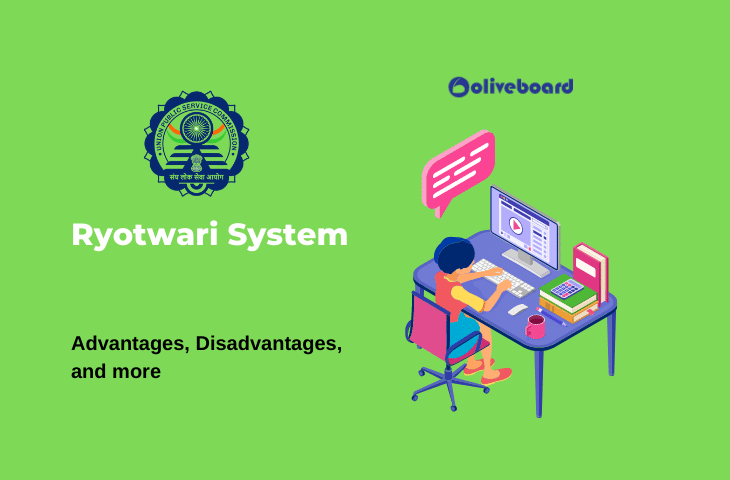In India, Sir Thomas Munro introduced the “Ryotwari System.” The Governor-General of Madras, Sir Thomas Munro, established the Ryotwari land revenue system in 1820 (first in Madras). The Ryotwari System is one of the three main systems used to collect revenues from the cultivators of agricultural land. This system was in operation for nearly 5 years and had many features of the revenue system of the Mughals. In Bombay, Madras, Assam, and Burma the Zamindar usually acted as a middleman between the government and the farmer.
Ryotwari System
- Thomas Munro established the Ryotwari System, which enabled the government to work directly with cultivators to collect income and allowed peasants to relinquish or purchase more land for agriculture. Ryotwari System is in the middle, with adjustments in position.
- This system had been in place for more than five years and had many similarities to the Mughal revenue system. It was established in some parts of British India as one of the three major systems for collecting revenue from agricultural land cultivators. When land income was charged directly on the ryots, the Ryotwari System of assessment was applied. The zamindari system of assessment was used when land revenue was imposed indirectly through agreements with Zamindars. The Zamindar was rarely utilized as a go-between for the government and the farmer in Bombay, Madras, Assam, and Burma.
- Every registered landholder is recognized as its proprietor under the Ryotwari System and pays directly to the government. He has the option of subletting his property or transferring it via sale, gift, or mortgage. He cannot be ousted by the government as long as he pays the fixed assessment and has the discretion to increase or decrease his holdings annually or to forsake it.
- Under this system, the Ryot is effectively a perfect title, with all the benefits of a perpetual lease without the responsibilities, in that he can throw up his lands at any time. However, as long as he pays his dues, he cannot be evicted; he receives assistance in difficult seasons and is irresponsible for the payment of his neighbors. Their goal is not to reassess the land but to calculate how much of the assessment due on his holding the Ryot must pay.
In British India, there are several different types of land revenue systems.
- Zamindari system
- Ryotwari system
- Mahalwari system
1. Permanent Settlement/ Zamindari System: During the British administration, the divisions of Bihar, Bengal, Banaras, and the NWFP amounted to around 19% of the total land.
2. Ryotwari System: During British administration, the Assam, Bombay, and Madras Presidencies covered roughly 51% of the territory.
3. Mahalwari System: During British administration, the Mahalwari System covered 30% of the country, including important areas of the NWFP, central provinces, and Punjab.
Advantages Of Ryotwari System
1. There were no intermediaries. The tax was levied on the ryots or cultivators directly.
2. The Ryot owned the land on which he farmed.
3. He has the option of transferring, selling, or mortgaging his property.
4. As long as he paid the revenue, he could not be expelled from his property.
5. During unfavourable seasons, assessment remissions were allowed.
6. The assessment was monetary and did not change year after year.
Disadvantages Of Ryotwari System
1. The taxes rate was fairly high.
2. The tax was not based on the real money generated by the land’s produce. It was based on a calculation of the soil’s potential.
3. In certain circumstances, the tax amounted to more than half of the gross revenue.
4. The tax has to be paid in cash. When crops failed, cultivators were forced to pay moneylenders.
Conclusion
In British India, there are several different types of land revenue systems. We hope the article provides you with the relevant details about the Ryotwari system. For any queries, contact us at Oliveboard.
FREQUENTLY ASKED QUESTIONS
Munro (later Sir Thomas) was the founder of the Ryotwari system
Capt. Alexander Read and Thomas (later Sir Thomas) Munro devised the method around the end of the 18th century, and the latter applied it when he was governor of Madras (1820–27).
It was also referred to as the Munro system.
They chose this structure because they believed there were no traditional zamindars and that a settlement was required. Sir Thomas Munro and Captain Alexander were the first to introduce the Ryotwari system.
Both the farmer and the Company were intimately linked in this structure. The land’s tiller was recognized as the property’s owner. The owner was required to pay the corporate government 50% of the produce as a land tax. The land tax was in place for thirty years.
The Company gathered revenues directly from the ryots in the Ryotwari System (farmers). Between the peasants and the government, there was no mediator like a Zamindar. The peasant was not removed from the land as long as he paid the revenue on time.
- UPSC Calendar 2026 PDF Out, Check All Exam Dates & Notifications
- UPSC EPFO Salary 2025, Pay Scale, Job Profile, Check Here
- UPSC Form Filling Format 2025, Get Latest Form Format in Detail
- What if I fail UPSC Prelims, How to Tackle UPSC Failure
- 10 Alternatives for UPSC Aspirants, Check 10 Best Alternatives
